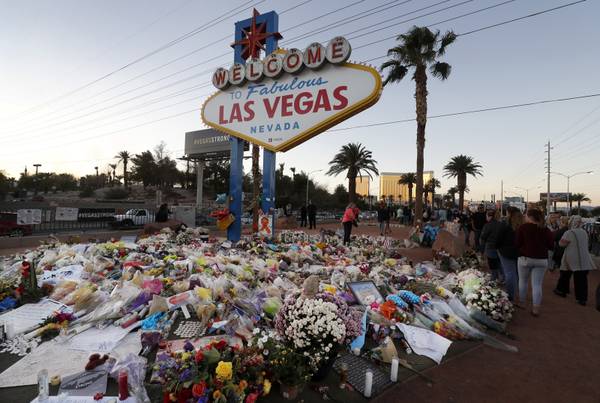Related content
The makeshift memorial on the Strip steps from the Route 91 concert venue was one way to grieve and bring the community together in the days after the Oct. 1 mass shooting.
We visited to pay our respects and console one other, and some of us added items to the display.
But what happens when those memorials run their course?
A group of historians gathered in Las Vegas last week to share pointers on preserving and cataloging the items with officials from the Clark County Museum.
With mass casualty occurrences in a variety of communities, Pam Schwartz, chief curator at the Orange County Regional History Center in Orlando, Fla., who organized the memorial items left behind after the Pulse Night Club shooting in June 2016, said one size doesn’t fit all.
“Different communities and their institutions collect for different reasons its sort of like asking somebody why they leave something at a memorial, there’s not just one answer to that,” Schwartz said. “The most obvious is for mourning. For some people, it’s replacing a loss with a gift. For some people, it’s a religious act and for some it’s just remembering their child.”
Schwartz said the shooting at the Pulse Night Club, which left 49 dead and 59 wounded, was no different than other events that shaped Central Florida.
“It’s a turning point. Our community will never be the same as it was before this,” she said. “As weird as the comparison might seem, it’s the same way as we would collect Disney. When Disney came to Orlando it totally changed everything. When NASA… came to Orlando it opened, literally, the universe to our community. Pulse is the same thing.”
The Clark County Museum began collecting the items for similar reasons, as they tell the story for the Las Vegas area, said Cynthia Sanford, registrar for the Clark County Museum.
“This is a very historical moment for Southern Nevada and we also tell the everyday life kind of history,” Sanford said. “The memorial shows one facet of our everyday life, that’s how we mourn these types of events and how that’s changed over the years.”
Archiving the items left at the various memorials, including the Welcome to Fabulous Las Vegas sign, will allow people to see how the process might have changed over time.
The items will help the museum show how Las Vegas came together as a community in one of its most trying times, Sanford said. With the community still going through the healing process, the artifacts can be a visual representation about that.
“The people who left things at the memorial, even if they didn’t have a connection to the victims, it affected them somehow too,” Sanford said. “Especially for Las Vegas, it was enough for them to pack 58 versions of something that they made, bring them here with them, and that says something about our culture in general.”
The Clark County Museum is in the process of cataloging between 15,000-20,000 artifacts from the memorial sites, with about 6,000 of them cataloged, photographed and numbered thus far. Sanford said they anticipate the process taking two years to complete.
About 25 volunteers are helping the museum catalog the items, that range from banners, large signs, pennies beads, rosaries, crosses and a wide variety of other items.
“They really wanted to give back to the community, they wanted to do something in regards to this and they’re there three days per week,” Sanford said. “I think it’s been a good opportunity for them, some of them are still very emotional about it, and every one of them have said they are honored to do it.”
When museum workers archive an item, it is uploaded to the internet. Those who left items are encouraged to go online and provide a story as to why they added it to the memorial. Viewing the item is one part of the experience — know the backstory is another important portion, officials said.
Even after a museum finishes recording all memorial items and host exhibit displays, the work is not over. With various remembrance milestones and other events, it’s an ever-evolving process, Schwartz said.
“These things aren’t over. It’s not like “OK, it’s been two years, we’re done,” the impacts go on,” she said. “The story keeps going… We’re at 22 months out and I’m still doing something pulse related every day.”
The Orange County Museum hosted six-month and one-year memorial displays of Pulse shooting artifacts, learning what families of the victims, survivors and first responders want in the exhibits and what they want omitted.
“They wanted to see the crosses, they wanted to see the community support,” Schwartz said. “They didn’t want to see or hear the perpetrators name… so we tried to be reflective of what we were hearing and try to pick items we thought would be more promoting of healing and support as opposed to be divisive items or things that can be traumatizing. “
The Clark County Museum hasn’t reached the point of planning a one-year memorial just yet, but the process is expected to begin soon, Sanford said. She’ll help guide the curator to what items should be included after her interactions with victims’ families and survivors.
It’s been an emotional process for all.
“I’m not a surgeon, I’m not a firefighter, but I am a historian... I’m something totally unrelated but I find myself in this work. It’s what we can give back to our communities,” Schwartz said. “We’re recording this for the history of our community. In 150 years for people to see how quickly it made a difference in the community and how it operates as a whole.”

